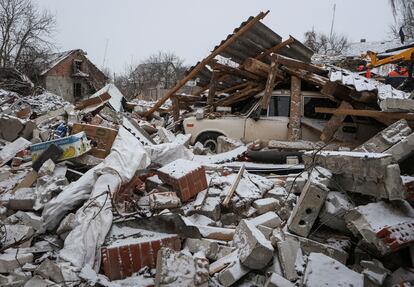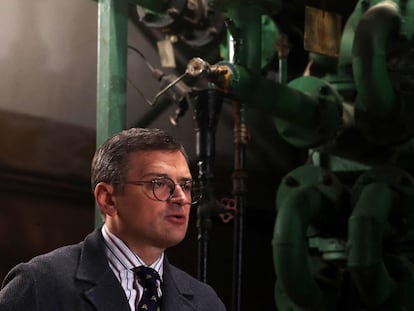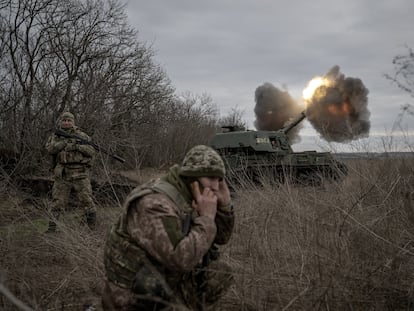Intensified Russian airstrikes are stretching Ukraine’s air defense resources, officials say
‘Intense Russian air attacks force us to use a corresponding amount of air defense means,’ air force spokesman Yurii Ihnat told national television. That’s why we need more of them,’ he added

Russia’s recent escalation of missile and drone attacks is stretching Ukraine’s air defense resources, a Ukrainian air force official said Tuesday, leaving the country vulnerable in the 22-month war unless it can secure further weapons supplies. “Intense Russian air attacks force us to use a corresponding amount of air defense means,” air force spokesman Yurii Ihnat told national television. “That’s why we need more of them, as Russia keeps increasing its (air) attack capabilities.”
As soldiers on both sides fight from largely static positions along the roughly 1,500-kilometer (930-mile) front line, recent Russian attacks have used large numbers of various types of missiles in an apparent effort to saturate air defense systems and find gaps in Ukraine’s defenses.
The massive barrages — more than 500 drones and missiles were fired between Dec. 29 and Jan. 2, according to officials in Kyiv — are also using up Ukraine’s weapons stockpiles. Ukraine uses weapons from the Soviet era and more modern ones provided by its Western allies. Authorities want to build up the country’s own weapons manufacturing capabilities, and analysts say those plants are among Russia’s recent targets.
“At the moment, we are completely dependent on the supply of guided air defense missiles, for both Soviet and Western systems,” Ihnat said.
President Volodymyr Zelenskiy said on Jan. 7 that “we lack a very concrete and understandable thing, that is air defense systems,” to protect civilian areas and troop positions. “We lack (air defense systems) both on the battlefield and in our cities,” he told a Swedish defense conference.
Speaking at a meeting with the Russian military brass, Defense Minister Sergei Shoigu declared that Kyiv’s efforts to bolster its firepower “won’t change the situation on the line of contact and will only drag out the military conflict.”
“We retain the strategic initiative along the entire line of contact,” Shoigu said. “We will consistently continue to achieve the objectives of the special military operation” — the Kremlin’s language for the war in Ukraine.
It was not possible to verify either side’s battlefield claims.
Ukraine, meanwhile, has increasingly targeted Moscow-occupied Crimea and Russian border regions with long-range strikes.
In the latest strike, two drones fell on the premises of a fuel and energy facility Tuesday in the Russian city of Orlov, about 250 kilometers (150 miles) from the Ukraine border, Gov. Andrei Klychkov said.
Three people were injured and a fire broke out but was quickly extinguished, Klychkov said.
The U.K. Defense Ministry pointed to repeated signs of shortcomings in Russia’s air defenses. Ukrainian strikes on military targets in Crimea on Jan. 4 demonstrate “the ineffectiveness of Russian air defenses in protecting key locations,” it noted Tuesday.
The Kremlin’s forces show no signs of easing off their winter campaign. In what officials called the biggest aerial barrage of the war, Russia launched 122 missiles and dozens of drones on Dec. 29, killing 62 civilians across the country. On Jan. 1, Russia launched a record 90 Shahed-type drones across Ukraine.
Russia has expanded its own production of missiles and drones, analysts say, and has begun using short-range missiles provided by North Korea.
Ukrainian officials have pleaded with the West for more weapons, especially air defense and artillery shells.
However, a plan by the administration of U.S. President Joe Biden to send to Kyiv billions of dollars in further aid is stuck in Congress, and Europe’s pledge in March to provide one million artillery shells within 12 months has come up short, with only about 300,000 delivered so far.
U.S.-made surface-to-air Patriot missiles give Ukraine an effective shield against Russian airstrikes, but the cost is up to $4 million per missile and the launchers cost about $10 million each, analysts say.
Such costly support is “essential” for Ukraine, a U.S. think tank said.
“The continued and increased Western provision of air defense systems and missiles to Ukraine is crucial as Russian forces continue to experiment with new ways to penetrate Ukrainian air defenses,” the Institute for the Study of War said.
Sign up for our weekly newsletter to get more English-language news coverage from EL PAÍS USA Edition
Tu suscripción se está usando en otro dispositivo
¿Quieres añadir otro usuario a tu suscripción?
Si continúas leyendo en este dispositivo, no se podrá leer en el otro.
FlechaTu suscripción se está usando en otro dispositivo y solo puedes acceder a EL PAÍS desde un dispositivo a la vez.
Si quieres compartir tu cuenta, cambia tu suscripción a la modalidad Premium, así podrás añadir otro usuario. Cada uno accederá con su propia cuenta de email, lo que os permitirá personalizar vuestra experiencia en EL PAÍS.
¿Tienes una suscripción de empresa? Accede aquí para contratar más cuentas.
En el caso de no saber quién está usando tu cuenta, te recomendamos cambiar tu contraseña aquí.
Si decides continuar compartiendo tu cuenta, este mensaje se mostrará en tu dispositivo y en el de la otra persona que está usando tu cuenta de forma indefinida, afectando a tu experiencia de lectura. Puedes consultar aquí los términos y condiciones de la suscripción digital.
More information
Últimas noticias
Most viewed
- Sinaloa Cartel war is taking its toll on Los Chapitos
- Oona Chaplin: ‘I told James Cameron that I was living in a treehouse and starting a permaculture project with a friend’
- Reinhard Genzel, Nobel laureate in physics: ‘One-minute videos will never give you the truth’
- Why the price of coffee has skyrocketed: from Brazilian plantations to specialty coffee houses
- Silver prices are going crazy: This is what’s fueling the rally










































